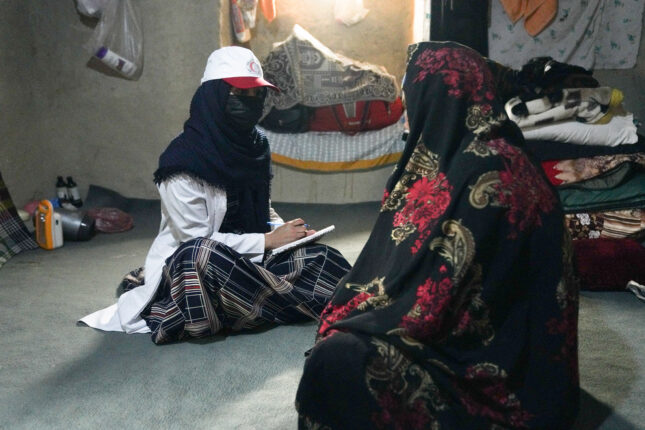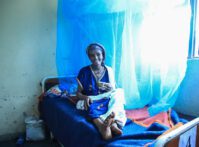-
Afghanistan Widows: The Silent Struggle of Women-Headed Households
February 19, 2025 By Massoma Jafari, Ijia Ormel, Faiza Rab, Basnama Ayaz, Carla Taylor & Salim Sohani
Close your eyes for a moment. Now imagine stepping back in time to an era when women in Western countries had no rights, no security, and no voice.
Now open your eyes again. In our own moment, millions of Afghan women—and in particular widows—live in just such a moment. This reality has never changed for them, and, in fact it has only worsened. Afghanistan remains one of the most repressive places in the world to be a woman: education is banned, employment is restricted, and even traveling alone is forbidden.
Widows in the country find life even more challenging. Afghan society expects women to be under the care of a male guardian—whether it be a husband, a father, or a brother. Women who have lost their guardian are left in an extremely vulnerable position, exposed to a high risk of poverty and exploitation.
These widows are known as “bisarparast” (or “without a guardian”), and they are left to fend for themselves in a world that offers little to no help. Many of them are compelled to return to their birth families, rely on in-laws, or depend on their young sons to support them.
While the exact figures remain uncertain, estimates suggest there are between 2 to 2.5 million war widows in Afghanistan. Many of them lost their husbands to decades of conflict, natural disasters, or disease. They now face a daily struggle for survival, remaining largely invisible to the world.
A Daily Struggle for Survival
Women in Afghanistan face severe restrictions on their movement, healthcare, and safety. Widows who lack a male relative are particularly isolated and unable to access basic necessities.
Imagine needing permission to see a doctor or buy food. With no male relative to accompany them, Afghanistan’s widows find themselves entirely isolated. Even those who were once financially independent struggle in a landscape in which women’s employment opportunities are increasingly restricted.
Widows not only endure a deep and pervasive loneliness, but they often face poverty, violence and exploitation. Gender-based violence (GBV) in Afghanistan has surged by 30% since 2021, impacting over 13 million women. Without education or job opportunities, many of the country’s widows are forced to beg, exposing themselves to even greater risks.
Afghanistan’s worsening economic crisis has meant that food has become a luxury. The World Food Program (WFP) reports that nearly all women-headed households face food insecurity. As a result, many widows resort to selling their possessions, skipping meals, or sending their children to work just to survive. Shockingly, one in ten widows has been compelled to marry off a daughter, even an underage child, to keep the rest of the family alive.
Winter inevitably brings even more devastation. Freezing temperatures, blocked roads, and fuel shortages make survival harder. Picture a mother wrapping her children in thin cloth as they shiver from the cold. With no money for fuel, no food to cook, and no one to turn to for help, this is the reality that most Afghan widows and their children must endure every winter.
What Can Be Done? A Realistic Approach
As winter tightens its grip and international funding declines, one question remains: how much longer can Afghan widows endure?
Their voices must be heard, their struggles acknowledged, and their rights restored. Until that happens, millions of Afghan widows will continue their silent fight for survival—one day at a time.
Despite a restrictive operating environment and challenges to access inside the country, organizations like the Afghan Red Crescent Society (ARCS) continue to provide aid under extremely difficult and challenging circumstances, despite their limited resources.
Targeted humanitarian aid can still reach widows, despite the current restrictions and challenges. Expanding emergency relief—such as food distribution, winter supplies, and basic healthcare—remains one of the few viable solutions to provide relief to people on the margins.
Strengthening local support networks and discreetly assisting widows through trusted community figures also can help ensure aid reaches those who are often left invisible and are most in need. Mobile healthcare units with female staff, while still navigating restrictions and safe access, can still provide lifesaving medical care, including health awareness and promotion.
Given the current context, economic empowerment may not be achievable through large-scale programs. Yet small-scale, home-based work that aligns with restrictions in place can provide widows with a modest income. And advocacy on international platforms remains crucial to maintaining pressure for incremental change. While major reforms seem unlikely in the near term, ensuring that widows receive access to basic necessities is a crucial step toward their survival.
As we have seen, the struggles of Afghan widows are real. Yet they remain largely unseen. Trapped between societal expectations, oppressive policies, poverty, and hunger, the plight of these women calls for urgent global attention. Their resilience is remarkable, but resilience alone will not feed their children, or keep them warm at night.
As international aid continues to shrink, the world must act. Even small, realistic interventions can make a difference in the lives of Afghanistan’s widows. It is imperative that donors, humanitarian organizations, and policymakers take urgent action. Sustained funding for local organizations providing essential healthcare, disaster response, and livelihood support is crucial to prevent further suffering and strengthen community resilience, particularly for widows and other vulnerable groups.
The crisis is real. Now is the time to step forward.
Read more about the Canadian Red Cross efforts to support the Afghan Red Crescent Society in their activities.
Massoma Jafari is a volunteer with the Canadian Red Cross.
Ilja Ormel is Senior Manager, Health Intelligence, Research and Development, at the Canadian Red Cross.
Faiza Rab is Senior Manager, Global Health and Research, at the Canadian Red Cross.
Basnama Ayaz is a volunteer with the Canadian Red Cross.
Carla Taylor is Head of Asia Pacific, International Operations at the Canadian Red Cross.
Salim Sohani is Senior Director Health in Emergencies at the Canadian Red Cross.
The authors would like to express their sincere appreciation to Canadian Red Cross staff members Sharonya Sekhar, Director Humanitarian Policy and Stephanie Murphy, Manager Communications.
Sources: The Afghan Times; Afghanistan Analysts Network; Amnesty International; The Loomba Foundation; Los Angeles Times; Radio Free Europe; Relief Web; UN; World Food Programme.
Photo credit: Afghan Red Crescent Mobile Health Team staff member providing essential health services to Afghan women. Meer Abdullah Rasikh / IFRC.
 A Publication of the Stimson Center.
A Publication of the Stimson Center.







